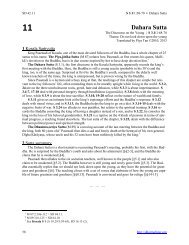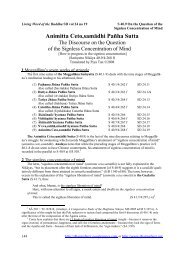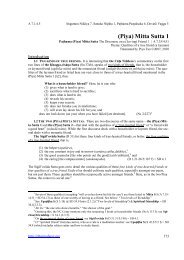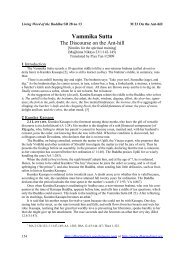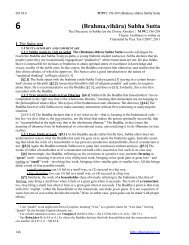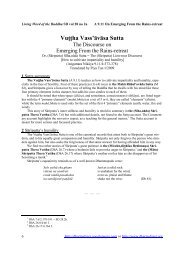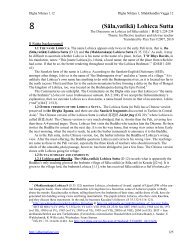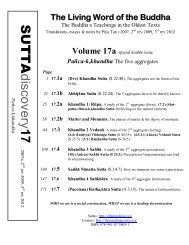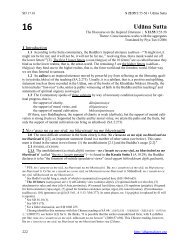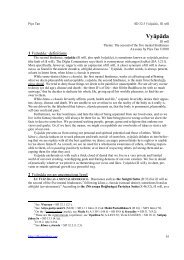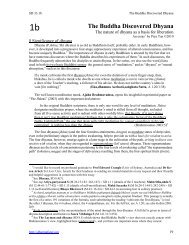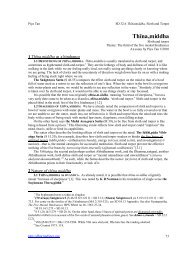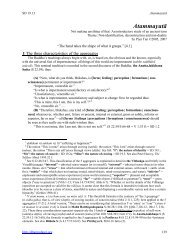Dhammaniyama Sutta - The Dharmafarers
Dhammaniyama Sutta - The Dharmafarers
Dhammaniyama Sutta - The Dharmafarers
Create successful ePaper yourself
Turn your PDF publications into a flip-book with our unique Google optimized e-Paper software.
Aṅguttara Nikya vol 1<br />
A 3.134 Dhamma,niyāma <strong>Sutta</strong><br />
Dhamma,niyāma <strong>Sutta</strong><br />
<strong>The</strong> Discourse on the Natural Orders<br />
Also called Uppāda <strong>Sutta</strong> (<strong>The</strong> Discourse on the Arising)<br />
[<strong>The</strong> characteristics of impermanence, suffering and not-self]<br />
(Aṅguttara Nikya 3.134/1:285)<br />
Translated by Piya Tan ©2008<br />
1 <strong>The</strong> three characteristics<br />
1.1 Very often, for years, we may take for granted that we have the right understanding of a certain<br />
teaching of the Buddha. <strong>The</strong>n one day, while meditating, listening to a Dharma talk, reading a Buddhist<br />
book, or simply being relaxed doing nothing in particular, we suddenly realize that we actually had it all<br />
wrong, or at least, the understanding is incomplete. Such a life-changing step into the clear light of the<br />
Dharma often comes when we are in touch with living spiritual masters who are themselves in touch with<br />
the Dharma. 1<br />
A case in point is that of the conventional wisdom regarding the famous statement of the three characteristics<br />
as, for example, in the Dhammapada: 2<br />
1 Sabbe saṅkhārā aniccā ti All formations [samskaras] are impermanent:<br />
yadā paññāya passati<br />
When one sees this with wisdom,<br />
atha nibbindati dukkhe<br />
then, one is revulsed at suffering—<br />
esa maggo visuddhiyā. This is the path to purity. (Dh 277)<br />
2 Sabbe saṅkhārā dukkhā ti All formations [samskaras] are suffering:<br />
yadā paññāya passati<br />
When one sees this with wisdom,<br />
atha nibbindati dukkhe<br />
then, one is revulsed at suffering—<br />
esa maggo visuddhiyā. This is the path to purity. (Dh 278)<br />
3 Sabbe dhammā anattā ti All dharmas [principles] are not self:<br />
yadā paññāya passati<br />
When one sees this with wisdom,<br />
atha nibbindati dukkhe<br />
then one is revulsed at suffering—<br />
esa maggo visuddhiyā. This is the path to purity. (Dh 279)<br />
A similar, but succinct, statement of the three characteristics is also found in the Dhamma,niyāma <strong>Sutta</strong><br />
(see translation below).<br />
Philosophically this sort of truth statement is said to apply sub specie aeternitatis, which according to<br />
the Philosophical Dictionary, 3 is Latin for “under the aspect of eternity.” In western philosophy, from<br />
Baruch Spinoza (1632-1677) onwards, it serves as an honorific expression describing what is universally<br />
and eternally true, without any reference to or dependence upon the merely temporal aspects of reality. In<br />
simple English, sub specie aeternitatis roughly means “from the perspective of the eternal.” More loosely<br />
or humorously, the phrase is used to describe an alternate or objective point of view.<br />
1.2 A popular interpretation of saṅkhāra is that they are “conditioned things,” that is, the world. <strong>The</strong><br />
better informed might even regard it technically as “the phenomena of experience as active participants in<br />
an ongoing process of cause and effect” (Sujato 2002). Broadly, we can take “formations” (saṅkhārā) to<br />
refer to all constructed things, that is, our mind-made world or the world in a psychological sense.<br />
1 This paper is inspired by Bhante Sujato’s short but important note on “All Dhammas” (2002).<br />
2 See also Is there a soul = SD 2.16 esp (8).<br />
3 Philosophical Dictionary, http://www.philosophypages.com/dy/s9.htm.<br />
http://dharmafarer.googlepages.com 103
Living Word of the Buddha SD vol 26 no 8<br />
A 3.134 On the natural orders<br />
<strong>The</strong> term dhamma, according to popular interpretation, has a much broader sense, and includes both<br />
conditioned phenomena and the unconditioned, that is, nirvana. 4 As such, it is sometimes translated freely<br />
as “things,” that is, all things, comprising both our mind-constructed world and the temporal-spatial<br />
world, the world in the psychological and the physical senses.<br />
As such, some scholars and scholarly teachers have this mistaken conclusion: “Dhamma can be applied<br />
to both conditioned and unconditioned things and states. It embraces both conditioned and unconditioned<br />
things including Nibbāna. In order to show that even Nibbāna is free from a permanent soul the<br />
Buddha used the term dhamma in the third verse.” 5 We will see that this is a very flawed notion.<br />
1.3 In a short but important note entitled “All Dhammas,” Bhikkhu Sujato (2002) points out that<br />
such an understanding is doubtful since nirvana is never referred to as “not-self” in the suttas. In the<br />
Mahā Māluṅkyā,putta <strong>Sutta</strong> (M 64), for example, we are admonished to reflect the five aggregates in<br />
this manner: 6<br />
Whatever that is therein that consists of form, of feeling, of perception, of formations, of consciousness,<br />
he regards those states as impermanent, as suffering, as a disease, as a tumour, as a<br />
barb, as a calamity, as an illness, as alien [as being other], as breaking up, as empty, as not self. 7<br />
He turns his mind away from these states. 8<br />
Having turned his mind away from these states, 9 he directs his mind to the deathfree element,<br />
thus:<br />
“This is peaceful, this is sublime, 10 that is, the stilling of all formations, the relinquishing of<br />
all acquisitions, the destruction of craving, dispassion, cessation, nirvana.” 11<br />
(M 64.9/1:435 f) = SD 21.10<br />
<strong>The</strong> purpose of this reflection is to be revulsed at suffering: we reflect phenomena as “suffering,” “a disease,”<br />
“a tumour,” and above all, as “not self.” 12 Clearly, nirvana is not included in such a reflection. 13<br />
4 IB Horner, in her Majjhima tr of the Cūḷa Saccaka S (M 35), for example, notes: “dhammā. <strong>The</strong>se include,<br />
beside the saṅkhārā (conditioned things), the unconditioned nibbāna as well.” (M:H 1:281). See foll n.<br />
5 Narada <strong>The</strong>ra in Dh:N 4 th ed 1993: 225 (italics added). A similar idea was held by W Rahula, What the<br />
Buddha Taught, 2 nd enl ed, 1967: 57 f.<br />
6 See also Sīlavanta S (S 22.122/3:168), Sutavanta S (S 22.123/3:169); Dutiya Nānā,karaṇa S (A 4.124/-<br />
2:128), Dutiya Mettā S (A 4.126/2:129), Jhāna S (A 9.36/4:423).<br />
7 “Impermanent…not self,” aniccato dukkhato rogato gaṇḍato sallato aghato ābādhato parato palokato suññato<br />
anattato: as at M 1:500; A 4:422 f; cf A 2:128. Comy says that the marks of suffering are sixfold (dukkhato<br />
rogato gaṇḍato sallato aghato ābādhato), the impermament twofold (aniccato palokato), the not self threefold<br />
(parato suññato anattato) (MA 3:146). This refrain (and the rest) shows the attainment of calm (samatha), leading<br />
to the cultivation of insight (vipassanā), or “insight preceded by calm” (samatha,pubbaṅgamā vipassanā), ie, on<br />
emerging from dhyana, one contemplates on it as an object of insight, reflecting it as having arisen through conditions,<br />
esp volition: see Aṭṭhaka,nagara S (M 52.4/1:350) = SD 41.2, where Comy says that this is samatha,pubbaṅgamā<br />
vipassanā; see (Yuganaddha) Paṭipadā S (A 4.170/2:157) = SD 41.5. In Kūṭa,danta S (M 74), this fornula<br />
is applied to the body, so that we are not attached to it (M 74.9/1:499) = SD 16.1.<br />
8 Comy: “He turns his mind away” (cittaṁ paṭivāpeti) from the 5 aggregates included in the dhyana, which he<br />
has seen to be marked with the 3 characteristics (of impermanence, suffering, not-self) (MA 3:146). He goes on to<br />
regard the dhyana or attainment, thus: “This is peaceful….nirvana” (see below).<br />
9 Comy: That is, from the five aggregates, all of which are marked by the 3 characteristics. (MA 3:146)<br />
10 Paṇītaṁ, as at M 2:235, 263; A 4:423, 5:8, 110, 320, 322, 354 ff.<br />
11 Etaṁ santaṁ etaṁ paṇītaṁ yad idaṁ sabba,saṅkhāra,samatho sabbûpadhi,paṭinissaggo taṇha-k,khayo<br />
virāgo nirodho nibbānan ti, as at M 1:136.<br />
12 In Sīlavanta S (S 22.122), it is stated that such a reflection if done consistently done makes us a streamwinner,<br />
and its continued practice progressively makes us a once-returner, a non-returner, and an arhat respectively<br />
(S 22.122/1:167).<br />
13 “It has been pointed out, however, that nirvana is referred to as “not-self” in the Vinaya Parivāra [V 5:86].<br />
This late compendium of monastic discipline is an odd place indeed to find such a statement, but at least this shows<br />
104<br />
http://dharmafarer.googlepages.com
Aṅguttara Nikya vol 1<br />
A 3.134 Dhamma,niyāma <strong>Sutta</strong><br />
That nirvana is not included is obvious: it cannot be categorized as “existing” (which entails eternalism)<br />
nor as “non-existing” (which entails annihilationism). 14<br />
One reason for the popularity of the view that “all dharmas” includes nirvana is probably to counter<br />
the opinion of some prominent scholars that nirvana is a kind of higher “Self.” As Sujato notes:<br />
<strong>The</strong> persistence of such ideas is quite astonishing in light of the Buddha’s consistent and unsparing<br />
condemnation of all doctrines of self, and the total lack of any hint that Nibbana is a “self.”<br />
However, it does not necessarily follow that the statement “all dhammas are not-self” refers to<br />
Nibbana. In fact, it’s a weak argument. One should never rely on a disputed interpretation of an<br />
ambiguous term to buttress one’s position in a debate.<br />
<strong>The</strong> <strong>The</strong>ravada commentaries offer conflicting opinions on this point—a sure sign that the<br />
teachers of old were not unanimous. One explanation has it that “sankharas” here means the<br />
“aggregate of sankharas” (ie various mental factors headed by volition), while “dhammas” means<br />
all five aggregates. I find this interpretation too arbitrary to do justice to the context. Elsewhere<br />
the commentaries suggest that “dhamma” includes “concepts” along with conditioned phenomena.<br />
This is interesting, but it rests on philosophical premises more characteristic of later strata of<br />
Buddhist thought, namely the distinction between ultimate truth and conventional truth.<br />
<strong>The</strong> main problem with all the above theories is that they lack sutta support. Ideally we<br />
should like [to find] an important sutta dealing directly with the three characteristics which refers<br />
to something as a “dhamma” while stating or implying that that “dhamma” is neither impermanent<br />
nor suffering. (Sujato, “All Dhammas,” 2007)<br />
<strong>The</strong> safest thing we can say here is that the statement “All dharmas [principles] are not self” (sabbe dhammā<br />
anattā) means that no abiding entity called a “soul” or whatever is found either within the five aggregates<br />
(our mind-body being) or outside of it, such as the view that “the self is the world” (so attā so<br />
loko). 15 In other words, we can only conclude that sabbe dhammā anattā means that “all dharmas (phenomena<br />
and the principles behind their conditionality) are not self.” 16 Nirvana, as we will see, does not fit<br />
anywhere in such a notion.<br />
2 Dhamma,niyāma<br />
2.1 According to the Dhamma,niyāma <strong>Sutta</strong> (A 3.134), the fact that all samskaras are impermanent<br />
and suffering, and that all dharmas are not self, is that “this element remains [this principle is stable], the<br />
fixedness of things, the order of things,” which the Buddha discovers and declares to the world (see translation<br />
below). What Sujato has to say here is very instructive and reproduced in full:<br />
<strong>The</strong> idea is that the principles of the dhamma are always true. Things are impermanent. In the<br />
past they were impermanent. In the future, too, they will be impermanent. While the sutta [A<br />
3.134] stops short of such a bold statement as “impermanence is permanent,” still the terms “stability”<br />
and “lawfulness” are virtually the opposite of “impermanence.”<br />
If the principles of the dhamma cannot be regarded as impermanent, neither, it would seem,<br />
should they be regarded as suffering. <strong>The</strong>y are not mentioned in the usual descriptions of suffering,<br />
nor do they fall into the threefold analysis of suffering as the suffering of painful feeling, the<br />
suffering of sankharas, and the suffering of change.<br />
So the principles of impermanence, suffering, and selflessness are the “dhamma” which is not<br />
impermanent or suffering; yet it seems plain enough that such principles are not-self. This is conthat<br />
such ideas were considered orthodox by the emerging <strong>The</strong>ravada school.” (Sujato 2007). <strong>The</strong> Parivāra was<br />
written in Sri Lanka (1st cent BCE, according to Norman, Pāli Literature, 1983:26).<br />
14 See eg Kaccā(ya)na,gotta S (S 12.15/2:16 f) = SD 6.13.<br />
15 See Pārileyya S (S 22.81.25/3:99) & SD 6.1 Intro (4); Attā Loko S (S 24.3/3:204 f).<br />
16 See also Saṅkhāra = SD 17.6 (6) & Cūḷa Saccaka S (M 35.4/1:228) = SD 26.4 n.<br />
http://dharmafarer.googlepages.com 105
Living Word of the Buddha SD vol 26 no 8<br />
A 3.134 On the natural orders<br />
firmed in a related discourse, 17 which uses similar phrases such as the “stability of dhamma” in<br />
the context of dependent origination. While the factors of dependent origination, the “dependently<br />
originated phenomena” headed by ignorance, are impermanent, the causal relationship between<br />
the phenomena remains fixed. Whenever there is ignorance, that will always give rise to conceptual<br />
activities, and so on. And it is precisely this consistent manner in which experience operates<br />
which creates the illusion of “self,” of a permanent essence or core underlying the transient fluctuations<br />
of experience. To see through this illusion, the Buddha taught us to make the conditional<br />
relation itself a focus of our investigation, to see experience neither as a random meaningless<br />
chaos, nor as diverse surface manifestations of a hidden inner unity, but as a flow of transient<br />
phenomena governed by natural laws.<br />
<strong>The</strong> three characteristics themselves are really little more than another perspective for examining<br />
conditionality. <strong>The</strong> suttas often treat “impermanent” as a virtual synonym for “dependently<br />
originated.” So in the end we can summarize like this. “Sankharas” means “conditioned phenomena,”<br />
while “dhammas” encompasses the conditioned phenomena as well as the principles of<br />
conditionality.<br />
This is useful. It reminds us that insight is not just “bare awareness” of transient phenomena,<br />
but must lead to an act of understanding, an intuitive realization of their fundamental nature. Seeing<br />
that “this thought is impermanent,” “this feeling is suffering,” “this idea is not-self,” we can<br />
let go of that thought, that feeling, that idea. But only when we see that “all thoughts are impermanent,”<br />
“all feelings are suffering,” “all ideas are not-self” can we let go of all thoughts, all feelings,<br />
all ideas.<br />
<strong>The</strong> key to thus universalizing the particulars of one’s own experience is conditionality.<br />
Again and again and again one sees thoughts arising when certain conditions are present; and<br />
again and again and again one sees that when those conditions are absent, thoughts do not arise.<br />
One bright day it clicks: one understands. This inner event is really quite mysterious. No-one<br />
can say how or when it will occur; and yet we can point out how to bring it about. When it<br />
happens, one has no thought of identifying or clinging to the passing parade of phenomena, the<br />
Mardi-gras of the mind, for one understands: all dhammas are not-self.<br />
(Sujato, “All Dhammas,” 2002; emphases added)<br />
2.2 <strong>The</strong> key phrase, “this element remains [is fixed], the fixedness of things, the order of things”<br />
(sā dhātu dhamma-ṭ,ṭhitatā dhamma,niyāmatā), of the Dhamma,niyāma <strong>Sutta</strong>, needs some explanation.<br />
<strong>The</strong> <strong>Sutta</strong>’s Commentary explains “things” (dhamma) as “the intrinsic nature of things” (sabhāva) (AA<br />
2:380), but this reflects a post-Buddha Abhidhamma philosophy, which however is helpful if we do not<br />
get too involved with philosophical discussion at the cost of understanding it for the sake of spiritual<br />
practice.<br />
<strong>The</strong> Commentary to the Paccaya <strong>Sutta</strong> (S 12.20) is more helpful, 18 saying that both dhamma-ṭ,ṭhitatā<br />
and dhamma,niyāmatā refer to conditions (paccaya). “This element” (sā dhātu), that is, the intrinsic<br />
nature of the conditions (paccaya,sabhāva), simply persists. It is never the case that birth is not a condition<br />
for decay-and-death. For, on account of a condition, the conditionally arisen phenomena persist (paccayena<br />
hi paccay’uppannā dhammā tiṭṭhanti); therefore, the condition itself is called the fixedness of<br />
things (dhamma-ṭ,ṭhitatā). <strong>The</strong> condition determines [fixes] the state (paccayo dhamme niyameti), therefore,<br />
it is called the order of things (dhamma,niyāmatā).<br />
This is the natural order of the universe and life itself: that all formations are impermanent and suffering,<br />
and all things are not self. That is to say, all phenomena arise by way of conditions, a network of<br />
causes and effects, which in turn proliferate further networks of causes and effects. All this is imperma-<br />
17 Evidently, Paccaya S (S 12.20/2:25-27) = SD 39.5.<br />
18 S 12.20/2:25-27 = SD 39.5. Comy: Ṭhitā’va sā dhātū ti ṭhito’va so paccaya,sabhāvo, na kadāci jāti jarā,-<br />
maraṇassa paccayo na hoti. Dhamma-ṭ,ṭhitatā dhamma,niyāmatā ti imehi pi dvīhi paccayam eva katheti. Paccayena<br />
hi paccay’uppannā dhammā tiṭṭhanti, tasmā paccayo’va dhamma-ṭ.ṭhitatā ti vuccati. Paccayo dhamme niyameti,<br />
tasmā dhamma,niyāmatā ti vuccati (SA 2:39)<br />
106<br />
http://dharmafarer.googlepages.com
Aṅguttara Nikya vol 1<br />
A 3.134 Dhamma,niyāma <strong>Sutta</strong><br />
nent and suffering, and both these impermanent and suffering phenomena, together with the principle<br />
(dhamma) behind them, are not self. This universal fixed order of things always exists in the universe and<br />
our lives, even before or after the arising of Buddhas. <strong>The</strong> Buddha does not create or invent all this, but<br />
merely discovers it, and declares in to the world. 19 As such, Bhikkhu Bodhi points out that<br />
<strong>The</strong> two expressions, dhammaṭṭhitatā dhammaniyāmatā, must thus have a meaning that is common<br />
to both dependent origination and the three characteristics, and it therefore seems unfitting<br />
to explain them here, as [the SA Ṭīkā] does, in a way that is specifically tied to conditionality.<br />
Moreover, it is more likely that here dhamma means the principle or lawfulness that holds sway<br />
over phenomena, not the phenomena subject to that principle. (S:B 742 n51)<br />
Hence, the paraphrased three-characteristic formula would read thus:<br />
sabbe saṅkhārā aniccā<br />
sabbe saṅkhārā dukkhā<br />
sabbe dhammā anattā<br />
all phenomena are impermanent;<br />
all phenomena are suffering;<br />
all dharmas (phenomena and the principles behind their<br />
conditionality) are not self.<br />
On a philosophical level, the key third line means that both constructed or projected reality as well as<br />
things as they are (that is, how the fully awakened mind would know them) are not self. Nirvana does not<br />
fit into either category: nirvana is neither self nor not-self.<br />
This discourse should be studied with the Paccaya <strong>Sutta</strong> (S 12.20), which presents dependent arising<br />
as the natural order of things. 20 — — —<br />
19 See SAṬ:VRI 2:42, but cf S:B 741 n51.<br />
20 S 12.20/2:25-27 = SD 39.5.<br />
http://dharmafarer.googlepages.com 107
Living Word of the Buddha SD vol 26 no 8<br />
A 3.134 On the natural orders<br />
<strong>The</strong> Discourse on the Natural Orders<br />
(A 3.134/1:285)<br />
1 Bhikshus, whether there is the arising of Tathagatas [Buddhas Thus Come] or not, this element<br />
remains [is fixed], the fixedness of things, the order of things, that 21<br />
sabbe saṅkhārā aniccā<br />
all formations [samskaras] are impermanent.<br />
A Tathagata fully awakens to this truth, realizes it. 22 Having fully awakened to it and realized it, 23 he<br />
tells, teaches, proclaims, establishes, reveals, analyses and clarifies that 24 “all conditioned things [samskaras]<br />
are impermanent.”<br />
2 Bhikshus, whether there is the arising of Tathagatas [Buddhas Thus Come] or not, this element<br />
remains [is stable], the fixedness of things, the order of things, that<br />
sabbe saṅkhārā dukkhā<br />
all formations [samskaras] are suffering.<br />
A Tathagata fully awakens to this truth, realizes it. Having fully awakened to it and realized it, he<br />
tells, teaches, proclaims, establishes, reveals, analyses and clarifies that “all conditioned things [samskaras]<br />
are suffering.”<br />
3 Bhikshus, whether there is the arising of Tathagatas [Buddhas Thus Come] or not, this element<br />
remains [is stable], the fixedness of things, the order of things, that<br />
sabbe dhammā anattā all dharmas [formations and principles] are not self. 25<br />
A Tathagata fully awakens to this truth, realizes it. Having fully awakened to it and realized it, he<br />
tells, teaches, proclaims, establishes, reveals, analyses and clarifies that “all things [dharmas] are impermanent.”<br />
— eva —<br />
Bibliography<br />
Sujato, Bhikkhu<br />
2002 “All Dhammas.” Bundanoon: Santi Forest Monastery, 2002. Accessed 6 Jan 2008 from<br />
http://santifm1.0.googlepages.com/writings2;<br />
http://santipada.googlepages.com/alldhammas.<br />
080107; 080108; 090805<br />
21 Uppādā vā bhikkhave tathāgatānaṁ anuppādā vā tathāgatānaṁ ṭhitā’va sā dhātu dhamma-ṭ,ṭhitatā dhamma,niyāmatā.<br />
22 Taṁ tathāgato abhisambujjhati abhisameti.<br />
23 Abhisambujjhitvā abhisametvā.<br />
24 “He tells…clarifies,” ācikkhati deseti paññāpeti paṭṭhapeti vivarati vibhajati uttānīkaroti: Comys say that<br />
although these are syns, they differentiate their usages thus: as an indication (uddesa) they “say” (ācikkhanti); as a<br />
description (niddesa) they “teach” (desenti); as a restatement (painiddesa) they “proclaim” (paññāpenti); by laying<br />
down the meaning in one way or other they “establish” (pahapenti); when showing the reason for a certain<br />
meaning they “reveal” (vivaranti); when showing the classification of a detail they “analyse” (vibhajanti); in order<br />
to do away with what is inverted or profound, or when creating a basis for their audience’s knowledge, they “clarify”<br />
(uttānikaronti); and when abolishing their audience’s ignorance and blindness in all these ways, they “make<br />
known [declare]” (pakāsenti) (VbhA 371; briefly at SA 2:40). On the ability to “instruct, inspire, rouse and gladden”<br />
one’s audience, see SD 6.1 & SD 11.4 Intro (4).<br />
25 This line means that no abiding entity called a “soul” or whatever is found either within the five aggregates<br />
(our mind-body being) or outside of it, such as the view that “the self is the world” (so attā so loko). 25 In other<br />
words, we can only conclude that sabbe dhammā anattā means that “all dharmas (phenomena and the principles<br />
behind their conditionality) are not self.” 25 Nirvana, as we will see, does not fit anywhere in such a notion. See Intro.<br />
108<br />
http://dharmafarer.googlepages.com



